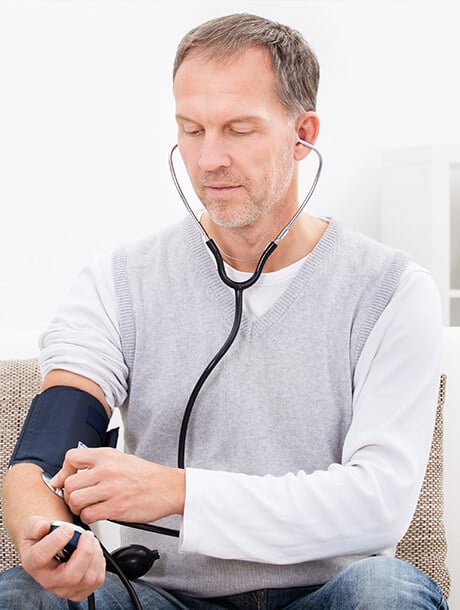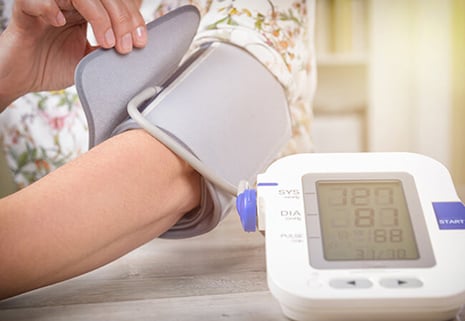Embrace a heart-healthy life with blood pressure management.
We want to help you make healthy decisions so you can live a long, fulfilling life. If you already have hypertension, get regular checkups to manage your symptoms. Your provider will likely prescribe a treatment plan and advise you on making healthy lifestyle changes. You may also need to take medications. The goal of treatment is to reduce your blood pressure enough to avoid more serious problems.
Early diagnosis and simple, healthy changes can keep high blood pressure from seriously damaging your health. Our blood pressure resources below can help you get on the right track and help you manage high blood pressure!
High blood pressure, also known as HBP or hypertension, occurs when the pressure of your blood is consistently too high against the walls of your blood vessels and arteries. Nicknamed "the silent killer", high blood pressure usually shows no symptoms, yet it can lead to life-threatening conditions like heart attack or stroke. That's why preventative care is essential.1
There are controllable and uncontrollable risk factors.2
Controllable:
- Smoking
- Diabetes
- Being overweight
- High cholesterol
- Unhealthy diet
- Lack of physical activity
Uncontrollable:
- Family history
- Race/ethnicity
- Age
- Gender
Some other, harder to manage factors include chronic kidney disease and obstructive sleep apnea.
- At your primary care provider's office
- At a pharmacy that has a digital blood pressure machine
- At home with a blood pressure monitor you use yourself
There are many home blood pressure monitors to choose from that can be purchased at a local pharmacy, medical supply store, or online.
Your health care provider may recommend a certain type of blood pressure monitor. If you are unsure, the American Heart Association recommends an automatic, upper arm blood pressure cuff.
Follow these tips to help ensure you get an accurate reading.
Before Your Reading:
- Don’t smoke, exercise, eat, or drink anything for 30 minutes
- Empty your bladder
- Sit in a comfortable chair with your back supported for at least 5 minutes
During Your Reading:
- Put both feet flat on the ground and keep your legs uncrossed
- Rest your arm comfortably on a flat surface at heart level
- Place the cuff on bare skin with the bottom of the cuff above the bend of your elbow
- Make sure the blood pressure cuff is snug but not too tight
- Do not talk while your blood pressure is being measured
American Heart Association's Blood Pressure Measurement Instructions
Going to the doctor can be stressful and lead to a false elevated reading. Plus, a single blood pressure measurement only tells what your blood pressure is at that moment. Keeping a record of your readings can provide a more complete picture over time and help ensure your treatment plan is working.
To keep track of your measurements, write them down on a piece of paper and store it in a place you'll remember. The American Heart Association has a free blood pressure log you can print and use at home. There are also apps you can download to your smart device that allow you to record, track, and analyze trends in blood pressure measurements. Some also allow you to share the data with your health care team.

What Does Your Blood Pressure Mean?
The top number in your blood pressure reading is "systolic pressure." This is the pressure in your blood vessels when your heart beats. The bottom number is "diastolic pressure" and it measures the pressure in your blood vessels between heart beats, at rest.3 Use this chart to see how your measurements stack up.
| Blood Pressure Category | Systolic | Diastolic |
|---|---|---|
| Normal | Under 120 | and under 80 |
| Elevated | 120-129 | and under 80 |
| Hypertension Stage 1 | 130-139 | or 80-89 |
| Hypertension Stage 2 | Over 140 | or over 90 |
| Hypertensive Crisis | Over 180 | and/or over 120 |
Taking Blood Pressure Medication
Many people need to take medicine in addition to making lifestyle changes to help keep their blood pressure at healthy levels. It’s important to take your medication as directed. Do not stop taking your blood pressure medicine or adjust your dose without talking to your doctor or health care team first as it could lead to serious health consequences.

.jpeg?width=970&height=820&name=image_adobe_express%20(1).jpeg)

